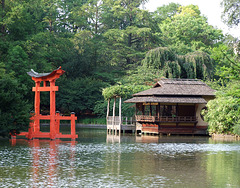 Mapping the Brooklyn Botanic Garden
Mapping the Brooklyn Botanic Garden

Advanced GIS
Final Project
Emily Baumbach
 Mapping the Brooklyn Botanic Garden
Mapping the Brooklyn Botanic Garden

Advanced GIS
Final Project
Emily Baumbach



AREAS OF THE GARDEN COEVERED IN THIS PROJECT INCLUDE THE FOLLOWING:





Brief History of Brooklyn Botanic Garden |
|
|---|---|
| Originally known as the Institute Park, the City of Brooklyn purchasd land, 39 acres, for a botanic garden in 1910. The area opened as the Brooklyn Botanic Garden on May 13, 1911, with the Native Flora Garden as teh first established section. Over the next three decades, garden grounds included the Osborne Garden, Cranford Rose Garden, Magnolia Plaza, and Plant Collection. The Conservatory and Laboratory Building were constructed beginning in 1912 | 
|
| Located in the Prospect Park neighborhood, the garden expands over 52 acres including a number of specialty gardens, plant collections, and the Steinhardt Conservatory Center which hold the Bonsai Museum, three climate-themes plant pavilions, an aquatic plant house, and an art gallery | 
|

Additional Notable Areas in the Garden |
|
|---|---|
| Shrine to the Shinto god of the harvest and protector of plants, Inari. People pray to Inari for a good harvest with food to be plenty. The building is typical of the traditional Shinto shrines in Japan. Shrines are usually found in the vicinity of temples. The woods used in the construction of this shrine were white cedar, ash, redwood and cypress. The structure is held together chiefly by wooden pegs. | 
|
| The Japanese Garden Pond is one of the oldest and most visited Japanese-inspired garden areas outside Japan.It is a blend of ancient hill-and-pond style with various landscape features gradually revealed along winding paths. The torii is a traditional Japanese gate most commonly found at the entrance of or within a Shinto shrine and marks the transition from the profane to the sacred. | 
|
| The Shakespeare Garden Displays more than 80 herbs, flowers, shrubs, and trees mentioned in the Bard's sonnets and plays. All items in the garden are hallmarks of an informal Elizabethan cottage garden. Gardens of this type contain a blend of edible and medicinal plants alongside decorative flowers. | 
|
| New York City and the surrounding region suffered tremendous damage and loss during Hurricane Sandy. In the wake of the devistation, BBG was inspired to creat a symbol of hope and revitalization. The Brooklyn Botanic Garden constructed a tree house called Sandy Remix as a project or reuse and recycling comprised of 14 kinds of trees. | 
|
| The Herb Garden is a decorative but utilitarian kitchen garden that opened in 2010 and tells the story of the worldwide origins of plants we use every day and reflects the many cultures and culinary traditions of Brooklyn's communities. This garden serves as a living classroom for practical urban gardening techniques and sustainable food choices. | 
|
